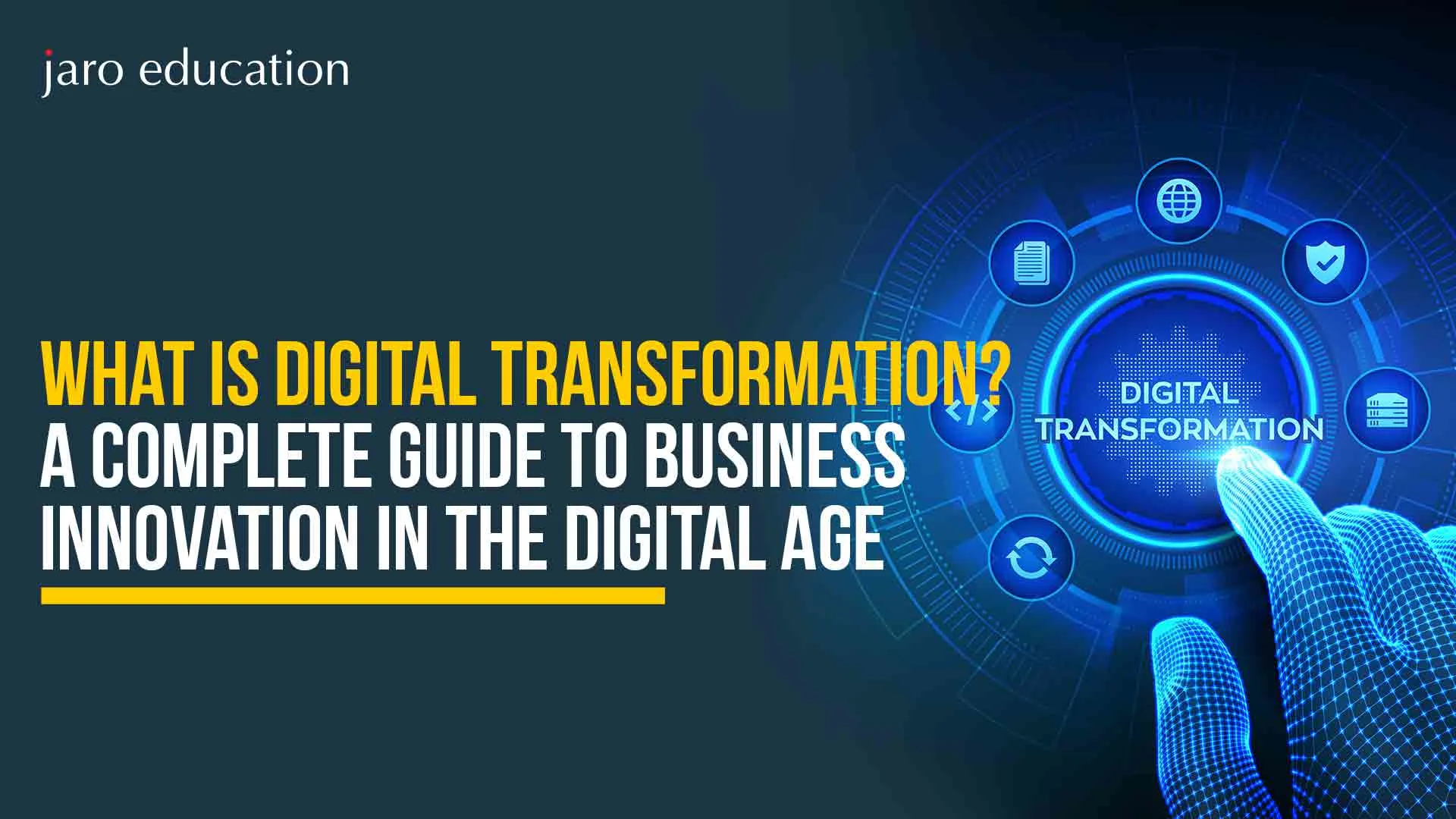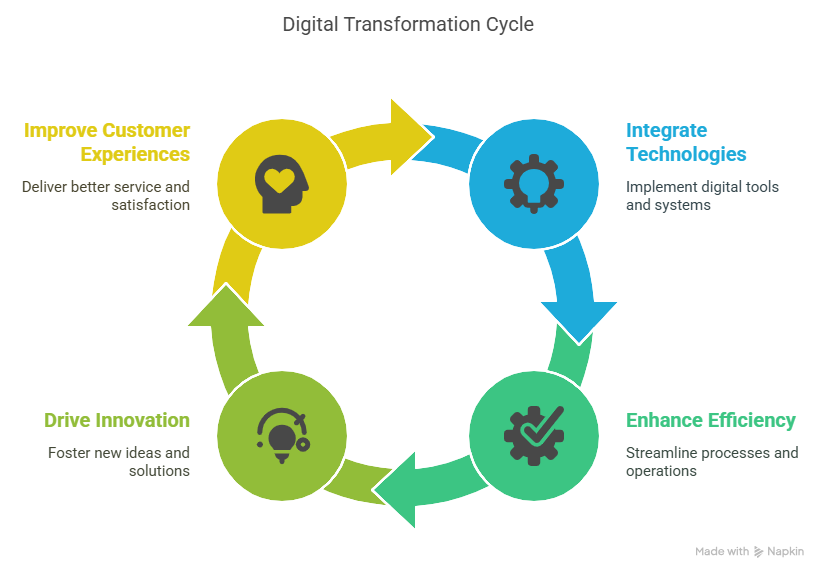What is Digital Transformation? A Complete Guide to Business Innovation in the Digital Age
Table of Contents

Digital transformation involves applying digital technologies to develop new or change existing — business processes, culture, and customer experience to address altered business and market needs. With today’s fast-changing environment, organizations can no longer count on conventional approaches to stay competitive. Industry 4.0 is leading the change, coupling intelligent technology with manufacturing, supply chains, and operations.
As digital transformation accelerates, it is becoming a required element in every organizational digital strategy. Enterprises in all sectors – healthcare, finance, education, and retail – are being transformed by emerging technologies: AI, cloud and data analytics. Adopting technology adoption not only makes companies more efficient but also improves customer interaction and decision-making capacity.
Digital transformation drives innovation across the enterprise, from improving internal processes to producing new products and services. In this blog, we will discuss how businesses can embrace the power of digital transformation, the importance of industry 4.0, the significant areas of an effective digital strategy, and the barriers to adopting new technology in the enterprise. Take a deep dive with us as we unfold the tools and knowledge required to succeed in this new digital world.
Understanding Digital Transformation
Digital transformation is not simply replacing one’s tools or procuring new software – it is a transformation that encompasses people, processes, organization culture, and vision. Digital transformation fundamentally reshapes how we work, creates value for customers, and competes for relevance – and is the foundational underpinning for Industry 4.0, which combines physical operations with digital intelligence aimed at productivity and innovation.
To truly understand digital transformation, it is worth differentiating it from related concepts. Digitization is the process of turning analog information into digital. Digitalization is the process of harnessing digital technologies to enhance business processes. On the other hand, digital transformation is a more fundamental and strategic transformation affecting the entire company. It means harmonizing all aspects of the firm — including leadership, management, and frontline workers — with a purposeful digital strategy for sustained success.
The most important factors catalyzing digital transformation are technology adoption, wherein firms embed sophisticated tools such as AI, cloud computing, and IoT to streamline operations and decision-making. No less significant is business model innovation, wherein firms reimagine how they produce and deliver value. Last but not least, organizational change is a key factor, transforming company culture, leadership behaviors, and workforce skills to sustain transformation.
A few of the top companies are excellent examples of successful digital transformation. Netflix transitioned from an old-fashioned DVD rental service to a worldwide streaming behemoth by leveraging data analytics and user-focused technology. Amazon revolutionized retail with unparalleled digital logistics and an incredible cloud platform. Adobe transformed from selling software licenses to providing cloud-based subscriptions, demonstrating how business innovation and adoption of technology can redesign a company’s destiny.
Through the adoption of the principles of Industry 4.0 and the development of a visionary digital strategy, companies can unlock opportunities for new growth and stay competitive in the digital era.

Why Digital Transformation is Imperative for Modern Businesses
In the current fast-paced digital era, customer expectations are undergoing a dramatic transformation. Customers today expect personalized experiences, real-time support, and frictionless digital interactions. For businesses to address these needs, they need to adopt digital transformation and shift towards a customer-driven strategy that relies on data and technology. This transformation is at the heart of Industry 4.0, when intelligent systems and smart devices drive the customer experience.
Today’s enterprises are also under intense pressure to enhance operational efficiency. Older systems and inefficient processes slow down productivity as well as scalability. By giving utmost importance to technology adoption, companies can automate mundane tasks, simplify workflows, and save money. Not only does this enhance speed and accuracy, but it also makes resources available for strategic growth projects.
It takes more than keeping up to remain competitive in an oversaturated market — it takes innovation. Digital transformation drives business innovation by allowing rapid business models and the quick rollout of new goods and services. A robust digital strategy keeps companies relevant and attuned to changing market conditions.
Moreover, data is a crucial factor today. Thanks to data-driven decisions, companies can not only find customer insights and track performance in real time but also make faster and better-informed decisions. The transition to digital maturity is a characteristic of the Industry 4.0 era, which is heavily focused on data-driven practices.
Additionally, the expansion of virtual and hybrid workforces has necessitated digital transformation. Secure remote access, cloud-based collaboration tools, and virtual communication platforms are essential to sustaining productivity and worker engagement in dispersed work groups.
In reality, adopting digital transformation is not a choice — it’s necessary for success in today’s business landscape.
Digital Transformation Pillars
Digital transformation is not a one-size-fits-all process. It addresses the different areas of a company, where it becomes a significant tool in achieving sustainable growth and competitiveness. These are the elements that form the basis of the sound digital strategy, thus becoming the main things enterprises need to introduce into their businesses so as to make them succeed in the context of Industry 4.0.
1. Customer Experience
Providing superior customer experiences is a key concern in every digital transformation initiative. Companies are emphasizing personalization, real-time interaction, and omnichannel assistance to please customers. Using data and technology, organizations can design smooth, customized interactions that enhance satisfaction and loyalty — signatures of business innovation in the current digital economy.
2. Operational Processes
Renewal of internal processes is essential to empower efficiency and agility. By using technology such as automation, AI, and cloud computing, companies can simplify their work, remove human errors, and speed up their decision-making. These advances lead to shorter reaction times and increased flexibility, which are the main benefits of Industry 4.0 capacities.
3. Business Models
The transition from analog to digital-first models is another foundation of transformation. Numerous companies are embracing subscription models, digital marketplaces, and platform-based services that provide recurring value and more intimate customer connections. This model facilitates business model innovation, enabling organizations to diversify revenue streams and rapidly respond to changing markets.
4. Culture and Leadership
For digital transformation to be a success, there has to be a change in mindset. Organizations require leaders who have a digital-first mindset and foster an agile mindset and continuous innovation. Creating a culture of experimentation and cross-functional work is essential to keeping up with accelerated technological change.
5. Technology Infrastructure
A solid technology foundation is essential for all transformation capabilities. Technologies such as AI, IoT, big data analytics, and cybersecurity have transitioned from options to necessary enablers of operational intelligence, secure scalability, and growth. Investing in the appropriate infrastructure enables the agility to forge ahead in an Industry 4.0 landscape.
All of these pillars enhance the value of an integrated digital strategy fueled by innovation, efficiency, and flexibility.
Benefits of Digital Transformation
Adopting digital transformation consists of a vast array of advantages that can immensely enhance a business’s performance and competitiveness. The following are some of the benefits of digital transformation:

- Improved Customer Satisfaction
- Provides tailored experiences and omnichannel assistance
- Fosters more robust customer relationships and loyalty
- Facilitates customer-focused digital strategy
- Improved Efficiency and Productivity
- Streamlines processes through technology implementation such as automation and cloud computing
- Eliminates manual labor and increases overall output
- Complies with Industry 4.0 concepts for intelligent workflows
- Improved Data Insights
- Allows real-time data gathering and analysis
- Enhances decision-making and performance optimization
- Powers informed and targeted business innovation
- Scalability and Innovation
- Supports business growth and agility
- Fosters innovative new ideas and quick reaction to market shifts
- Aids in sustainable business model innovation
- Faster Time-to-Market
- Accelerates product and service creation
- Improves competitiveness and responsiveness to the market
- Exercises a firm’s entire digital transformation journey
Common Challenges and Risks of Digital Transformation
Although digital transformation brings many advantages, it also has challenges that companies need to tread carefully. Resistance to change is among the most common obstacles. Employees and management might resist implementing new technologies or changing entrenched processes, and hence, cultural transformation has become an integral component of any digital strategy.
Sizable initial costs may also discourage organizations from making an investment in technology adoption. Installing new tools, updating hardware, and training employees are capital-intensive, particularly for small and mid-size businesses. Even if the long-term ROI is assured, these expenses can create short-term financial pressures.
Another major challenge is the integration of legacy systems with new technologies. Most firms depend on outmoded platforms that do not integrate well with new solutions, hindering the shift to Industry 4.0 settings.
There is also a talent shortage problem. The need for talented data science, cybersecurity, and digital development professionals frequently exceeds availability, creating challenges for firms to expand their business innovation activities.
Finally, security and compliance concerns are significant threats. As companies digitize their operations and manage more customer information, they’re exposed to more cyber attacks and regulatory fines. A compliant, secure digital infrastructure is necessary for a successful and secure digital transformation strategy.
How to Implement Digital Transformation Successfully
There is more to digital transformation than simply implementing new tools — it is a process that aligns technology, processes, and people systematically and strategically. With the rise of Industry 4.0, organizations must take a step-by-step approach to stay innovative and competitive.
Set Clear Goals and Vision
Start with a solid foundation by outlining your transformation goals. Align your vision with the organization’s long-term digital strategy, so that all stakeholders are aware of the intended outcomes.
Carry Out a Digital Maturity Assessment
Assess where your company is today when it comes to technology utilization, processes, and digital culture. This assists in the identification of gaps and prioritizing areas for technology adoption and enhancement.
Select scalable, flexible, and secure technologies like cloud computing, AI, and big data analytics. These are the pillars of Industry 4.0 and fuel valuable business innovation.
Construct Cross-Functional Teams
Establish groups that align IT, operations, sales, and marketing to achieve a comprehensive transformation. Working together improves problem-solving and seamless integration across departments.
Upskill Workforce and Adopt Change Management
Empower the workforce by training and developing employees. A talented and flexible workforce is essential for adopting change and delivering the digital transformation vision.
Monitor, Iterate, and Continuously Improve
Leverage real-time data and feedback to make strategies better. An agile framework allows companies to respond rapidly in an ever-changing setting.
Role of Leadership and Change Agents
Effective leadership is crucial in order to spur change and momentum. Identified change agents can be the champions of initiatives, foster innovation, and bridge resistance.
Application of KPIs and ROI Measurement
Monitor progress through clearly stated KPIs. Monitor the ROI of digital projects to support alignment with the overall digital strategy and to inform investments in the future.
Through these steps, organizations are able to overcome the intricacies of digital transformation and unleash long-term prosperity.
Join IIM Kozhikode’s Professional Certificate Programme in Digital Marketing for Performance and Growth
Enroll in IIM Kozhikode’s Professional Certificate Programme in Digital Marketing for Performance and Growth to empower professionals with innovative tactics and tools to be digital leaders. In partnership with Jaro Education, this elite program marries IIM Kozhikode’s academic rigor with Jaro’s proficiency in professional education to ensure all-encompassing and industry-aligned learning that brings tangible impact and career growth.
Conclusion
In the fast-paced digital world of today, digital transformation is no longer a choice — it is necessary to achieve long-term success and sustainability. Through the adoption of technology, companies can tap new heights of efficiency, customer satisfaction, and data-driven decision-making. A properly aligned digital strategy, guided by the precepts of Industry 4.0, enables companies to foster business innovation, stay competitive, and respond to new market conditions.
But digital transformation is not a one-time initiative; it’s an ongoing journey. With changing technology, organizational processes, culture, and competencies also need to change. Those companies that evolve at the forefront of this change, invest appropriately in tools, and develop a culture of agility and innovation are those that will dominate in the age of digital.
To succeed in this new era, organizations need to see digital transformation as a constant strategic imperative — one that requires vision, collaboration, and ceaseless innovation.
Frequently Asked Questions
What is digital transformation in simple words?
Digital transformation is the name for the process of using digital technologies to totally change the way business operates and to be able to deliver value to customers in more efficient ways.
What are the 4 main areas of digital transformation?
Business process, business model, domain transformation, and organizational culture change are the four primary domains of digital transformation.
What is the digital transformation of a business strategy?
A business strategy’s digital transformation includes adopting digital tools and making data-driven decisions to enhance operations, customer experience, and innovation.
What is an example of digital transformation?
One example of the many that can be given in favor of digital transformation is a retail business that is adopting e-commerce, AI for customer service, and analytics to increase interaction with its customers.
What are the benefits of digital transformation?
Benefits associated with going digital are seen in improved efficiency, customer service quality, faster decision-making, and higher market competition rates through digital transformation.


















